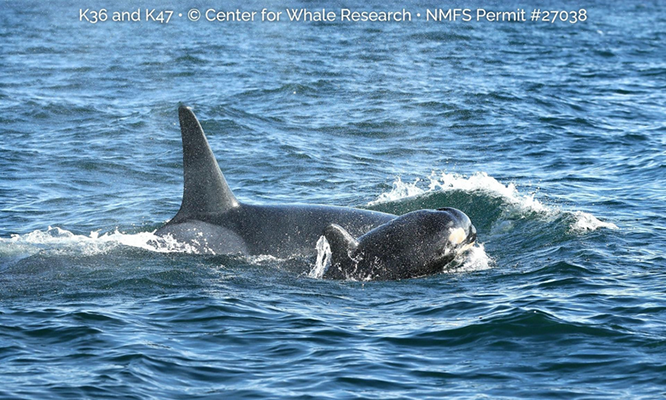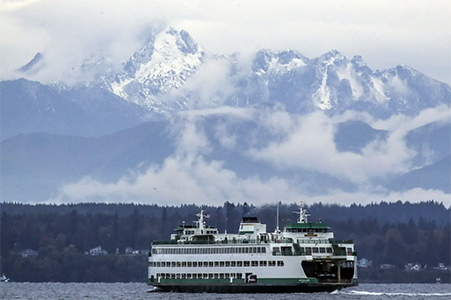— by Michael Riordan for Sightline —
This article is part of the series “The Risk of Northwest Oil Spills”
Every week another barge or tanker traverses the narrow straits through the San Juan Islands north of Seattle, bearing a cargo of tar-sands crude or other heavy oils from Canada, headed for refineries in Washington and California. But the Kinder Morgan Trans Mountain Pipeline Expansion Project approved in late 2016 by the government of Canadian Prime Minister Justin Trudeau threatens to make such transits daily occurrences, thus increasing many-fold the chances of a major oil spill in the Salish Sea and other Pacific Northwest waters.
The $7.4 billion Kinder Morgan project would add another pipeline alongside one that already extends from Edmonton, Alberta, to the Westridge Terminal in Burnaby, near Vancouver, British Columbia. It would increase the system’s capacity from 300,000 to 890,000 barrels per day. Most of the additional oil would be tar-sands crude that would be loaded onto another 348 tankers plying the Salish Sea every year.
In order to flow through pipelines, the viscous, tarry bitumen mined in Alberta must be diluted with light hydrocarbons like benzene or naphtha—and is thus called diluted bitumen, or “dilbit” for short. If the dilbit were to be spilled from a tanker into the Northwest’s inland sea, a portion of it might be corralled and removed by prompt action of the Canadian or US Coast Guard and other responders.
But not all of it. (To read the full article, go to https://www.sightline.org/2017/05/22/the-tar-sands-threat-to-northwest-waters/ )
**If you are reading theOrcasonian for free, thank your fellow islanders. If you would like to support theOrcasonian CLICK HERE to set your modestly-priced, voluntary subscription. Otherwise, no worries; we’re happy to share with you.**








The expression “you reap what you sow” comes to mind.
The Obama administration’s multi-year stalling on the Keystone pipeline decision which culminated in its rejection late in his term spurred business to find alternative outlets for this product. Now that President Trump has reversed the Obama decisions, there will probably be a shift back towards piping more of the oil through the lower 48 rather than to the west coast.
The process is much like the issues that ramped up the amount pf crude oil transportated by railcars. Not an efficient or nearly as safe a method as pipeline transport but if pipelines are blocked it will find another way to market because we are dependent on oil for energy and as a critical component of so much we use (plastics, synthetics, etc.).
The next time you push to block a pipeline, you should ask – “If they don’t get to build that pipeline, how will that oil get to market?”
I can only second Mr. Webster’s observations.
He has just written everything I, also, have been saying.
When you are deciding to protest something, it’s best to include the consequences of success in the discussion.
Ride your bike, you two!
I understand the logic of the above two comments if our goal is to continue using fossil fuels. But if we’re trying to kick the habit it seems that some serious sacrifice and reprioritizing is necessary. Fast forward 25-30 years when both artics are all water, 1/3 or more of all habitable land is underwater and the displacement of peoples here and around the world are Syria times 1000. And that’s just the beginning. Believe me, for the sake of yourselves, your children and your grandchildren, you’ll wish you had changed the thinking back in the early 2000’s. The kicker in all this is that we, with our enlarged brains, are the ones bringing so much havic to this planet. Heck, the dinosaurs lived for three periods or 165-million years; we’ve only been around about 7 million years and only began flaking off crude stone about 2.5 million years ago. They were taken out by an ateroid hitting in the Yucatán; we’ll be lucky to survive another 100-200 years and you can bet it’ll be ourselves who did the handi-work—all because of our so-called enhanced brains. It really makes you wonder if we’re too big, mentally, for our britches (or as Davy Crockett wrote about Andrew Jackson, “breeches”) —are we not in so many ways just “children” possessing dangerous toys. The irony of it all is too much to bare. Makes me ask just one question above all: where’s the humility? I’m just saying…
Sorry for the typos and my so called self-correcting “smart”-phone–“havoc” and “arctic”…, not smart enough, apparently…lol